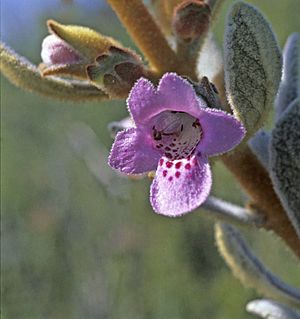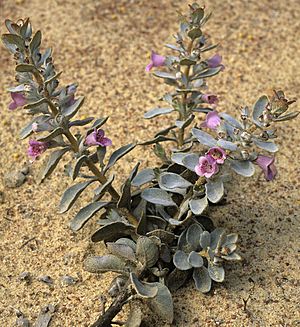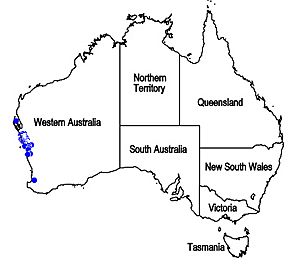Oldfield's foxglove facts for kids
Quick facts for kids Oldfield's foxglove |
|
|---|---|
 |
|
| Quoya oldfieldii in Kalbarri National Park | |
 |
|
| (Kings Park, Perth) | |
| Scientific classification | |
| Genus: |
Quoya (plant)
|
| Species: |
oldfieldii
|
 |
|
| Occurrence data from ALA | |
| Synonyms | |
Quoya oldfieldii, also known as Oldfield's foxglove, is a pretty flowering plant. It belongs to the mint family called Lamiaceae. You can only find this plant in the south-west part of Western Australia. It grows as an upright bush. Its branches and leaves are covered in soft, brownish hairs. The leaves look like eggs, and its tube-shaped flowers are pink with cool purple spots inside.
Contents
What Oldfield's Foxglove Looks Like
Quoya oldfieldii is an upright shrub. It usually grows to be about 0.5–1.5 m (2–5 ft) tall. Its branches are covered in thick, reddish-brown hairs. These hairs become lighter brown on older parts of the plant.
The leaves of this plant are shaped like eggs. They are narrower at the bottom. Each leaf is about 2–4.5 cm (0.8–2 in) long and 1.5–2.5 cm (0.6–1 in) wide. They are covered in woolly hairs. The top of the leaves is grayish-green, and the bottom is yellowish-green.
Flowers and Fruit
The flowers grow in groups of 3 to 7. They appear where the leaves meet the stem, called the axil. Each group of flowers grows on a hairy stalk that is 1–2 cm (0.4–0.8 in) long. Small leaf-like parts called bracts surround the flowers.
The flowers have five sepals. These are like small leaves that protect the bud. They are 8–10 mm (0.3–0.4 in) long and joined together for about half their length. The outside of the sepals is very hairy.
There are also five petals that form a tube. This tube is 18–23 mm (0.7–0.9 in) long. The flowers are pale pink with purple dots inside. The tube has five lobes at its end. The lowest lobe is very wide and round. It is twice as big as the other lobes. The outside of the petal tube is hairy, but less so than the sepals.
Inside the flower, there are four stamens. These are the parts that make pollen. They are about the same length as the petal tube. Oldfield's foxglove usually flowers from May to November or December. After flowering, the plant produces fruit. The fruit is oval or almost round, about 3–4 mm (0.1–0.2 in) long, and hairy. The sepals stay attached to the fruit.
How it Got its Name
This plant was first officially described in 1859. A scientist named Ferdinand von Mueller gave it the name Chloanthes oldfieldii. He wrote about it in his book Fragmenta phytographiae Australiae. The plant he described was found by Augustus Oldfield near the Murchison River.
Later, in 2011, two other scientists, Barry Conn and Murray Henwood, changed its name to Quoya oldfieldii. They published this change in a science journal called Australian Systematic Botany. The second part of the name, oldfieldii, is a way to honor Augustus Oldfield. He was the person who collected the first sample of this plant that scientists studied.
Where Oldfield's Foxglove Lives
Oldfield's foxglove grows in sandy and gravelly soils. You can find it on sandplains. Its main home is between the towns of Geraldton and Shark Bay in Western Australia. This area includes parts of the Geraldton Sandplains and Yalgoo regions.
Is it Protected?
The Western Australian Government's Department of Parks and Wildlife has looked at Quoya oldfieldii. They have decided that this plant is "not threatened." This means it is not currently in danger of disappearing.

